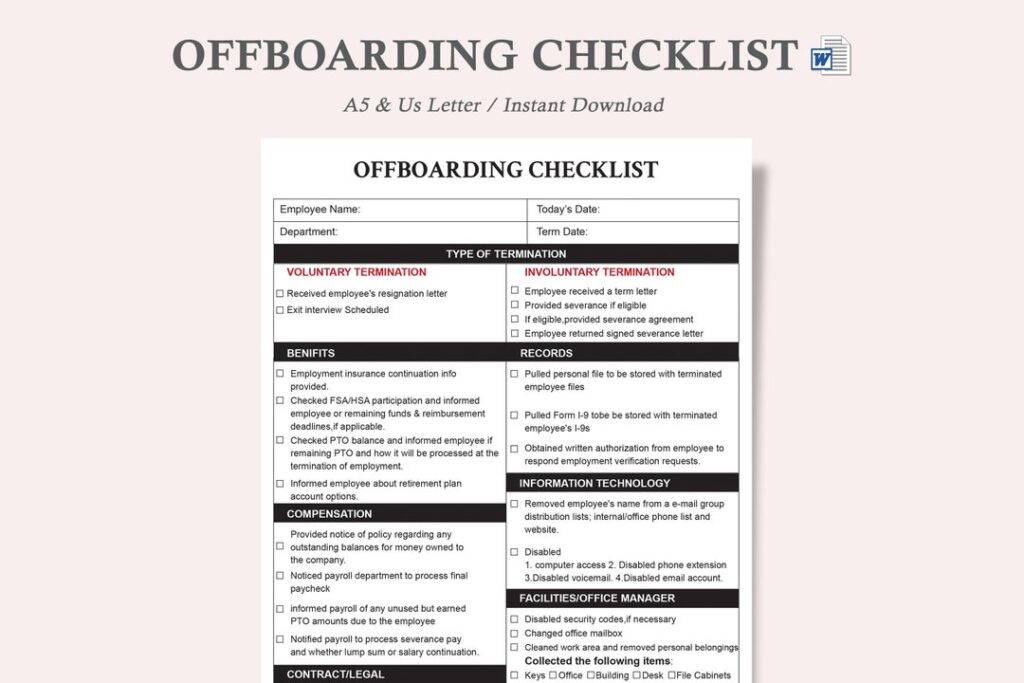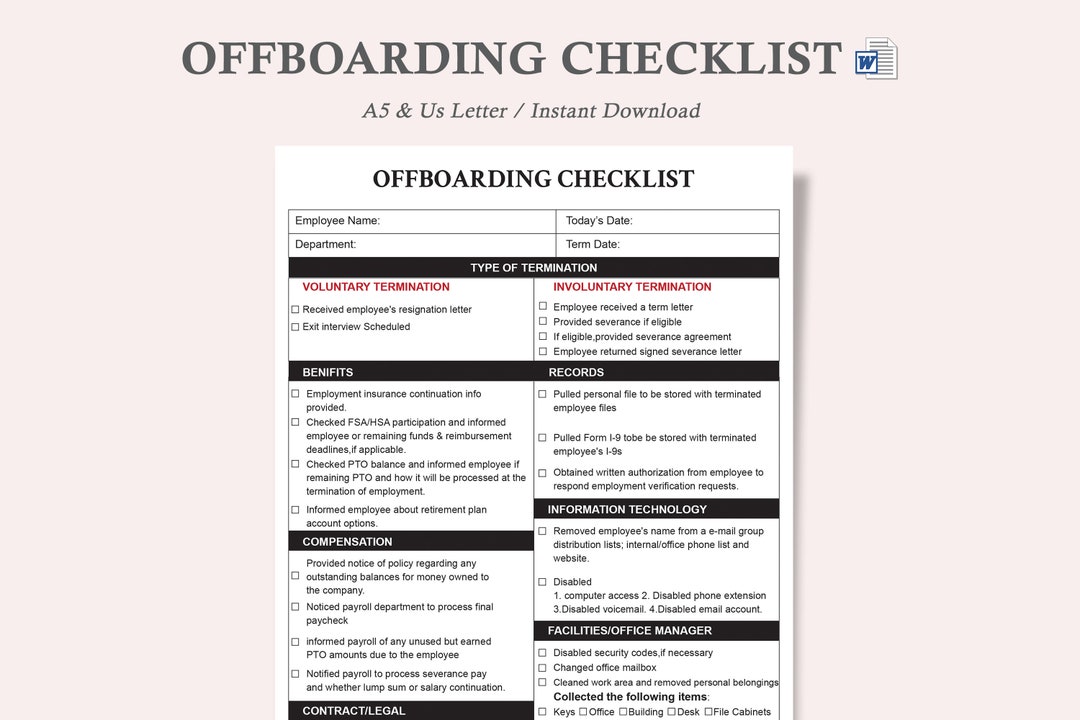
The Ultimate Employee Offboarding Checklist: A Comprehensive Guide
Employee offboarding, often overlooked, is a critical process that can significantly impact a company’s reputation, security, and overall employee morale. A well-structured employee offboarding checklist ensures a smooth and professional transition, protecting sensitive information and maintaining positive relationships with departing employees. This comprehensive guide outlines everything you need to include in your employee offboarding checklist to ensure a seamless and compliant process.
Why is an Employee Offboarding Checklist Important?
Effective employee offboarding is more than just administrative paperwork. It’s about risk management, maintaining a positive employer brand, and ensuring compliance. Here’s why a detailed employee offboarding checklist is essential:
- Security: Prevents unauthorized access to company data and systems after the employee’s departure.
- Compliance: Ensures adherence to legal and regulatory requirements related to final pay, benefits, and data privacy.
- Reputation: Maintains a positive employer brand by ensuring a professional and respectful exit experience.
- Knowledge Transfer: Captures critical knowledge and processes before the employee leaves.
- Morale: Demonstrates respect for the departing employee, which can positively influence remaining employees.
Key Components of an Employee Offboarding Checklist
A robust employee offboarding checklist should cover several key areas. Here’s a breakdown of the essential components:
Pre-Departure Tasks (2-4 Weeks Before Departure)
- Notification and Announcement:
- Receive and acknowledge the employee’s resignation letter.
- Inform relevant departments (HR, IT, Legal, Management).
- Prepare an internal announcement, if appropriate, and coordinate its release.
- Knowledge Transfer Planning:
- Identify key responsibilities and projects.
- Schedule knowledge transfer sessions with designated team members.
- Document processes, procedures, and critical information.
- Project Handover:
- Assign ongoing projects to new owners.
- Ensure all project documentation is updated and accessible.
- Conduct handover meetings to brief new owners on project status and requirements.
- System Access Review:
- Review the employee’s system access rights.
- Plan for the revocation of access on the employee’s last day.
- Identify any shared accounts or access points that need to be updated.
- Exit Interview Scheduling:
- Schedule an exit interview with HR or a designated manager.
- Prepare a list of relevant questions to gather feedback and insights.
Departure Day Tasks
- Return of Company Property:
- Collect company-issued laptops, mobile phones, and other devices.
- Retrieve employee badges, access cards, and keys.
- Ensure the return of any company documents, files, or intellectual property.
- System Access Revocation:
- Revoke the employee’s access to all company systems and applications.
- Disable email accounts and redirect incoming messages as needed.
- Update passwords and security protocols for any shared accounts.
- Exit Interview:
- Conduct the exit interview to gather feedback on the employee’s experience.
- Document the interview findings and identify areas for improvement.
- Final Paycheck and Benefits Information:
- Provide the employee with their final paycheck and a detailed statement of earnings.
- Explain the employee’s rights and options regarding benefits continuation (e.g., COBRA).
- Provide information on retirement plan options and procedures.
- HR Paperwork Completion:
- Complete all necessary HR paperwork related to the employee’s departure.
- Provide the employee with any required documentation (e.g., termination letter).
- Ensure all records are accurately updated in the HR system.
Post-Departure Tasks
- Account Deactivation and Archiving:
- Deactivate or archive the employee’s email account and other system accounts.
- Ensure all data is securely stored and accessible for future reference.
- Knowledge Base Updates:
- Update the company’s knowledge base with any new information or insights gained during the knowledge transfer process.
- Ensure all documentation is current and accurate.
- Security Audit:
- Conduct a security audit to ensure all access points have been secured.
- Review system logs for any suspicious activity.
- Update security protocols as needed.
- Feedback Analysis and Process Improvement:
- Analyze the feedback gathered during the exit interview.
- Identify areas for improvement in the employee offboarding process.
- Implement changes to enhance the offboarding experience for future departing employees.
- Communication with Remaining Team:
- Communicate any changes in responsibilities or team structure to the remaining employees.
- Address any concerns or questions that may arise.
- Reinforce the company’s commitment to employee well-being and development.
Creating a Customized Employee Offboarding Checklist
While the above checklist provides a comprehensive framework, it’s essential to customize it to fit your organization’s specific needs and requirements. Consider the following factors when creating your employee offboarding checklist:
- Industry: Different industries may have unique compliance and security requirements.
- Company Size: Larger companies may have more complex offboarding processes than smaller ones.
- Role: Executive-level departures may require additional steps and considerations.
- Legal and Regulatory Requirements: Ensure compliance with all applicable laws and regulations.
Tips for Effective Employee Offboarding
To ensure a successful employee offboarding process, keep these tips in mind:
- Start Early: Begin the offboarding process as soon as the employee gives notice.
- Communicate Clearly: Keep the employee informed throughout the process.
- Be Organized: Use a checklist to ensure all tasks are completed.
- Be Respectful: Treat the departing employee with dignity and respect.
- Gather Feedback: Use the exit interview to gather valuable insights.
- Document Everything: Keep accurate records of all offboarding activities.
Technology’s Role in Streamlining Offboarding
Leveraging technology can significantly streamline the employee offboarding process. HR software and automated workflows can help manage tasks, track progress, and ensure compliance. Consider implementing the following technological solutions:
- HR Information Systems (HRIS): Automate tasks such as benefits administration and final pay calculations.
- Identity and Access Management (IAM) Systems: Streamline the revocation of system access and password updates.
- Workflow Automation Tools: Create automated workflows for offboarding tasks, ensuring consistency and efficiency.
- Document Management Systems: Securely store and manage all offboarding documentation.
Potential Pitfalls to Avoid
Several pitfalls can derail the employee offboarding process. Here are some common mistakes to avoid:
- Lack of Planning: Failing to plan for offboarding can lead to missed steps and potential security breaches.
- Poor Communication: Inadequate communication can create confusion and resentment.
- Neglecting Knowledge Transfer: Failing to capture critical knowledge can disrupt business operations.
- Ignoring Compliance Requirements: Non-compliance can result in legal penalties and reputational damage.
- Failing to Secure Data: Leaving system access open can compromise sensitive information.
The Long-Term Benefits of a Strong Offboarding Process
Investing in a robust employee offboarding checklist and process yields significant long-term benefits. These include:
- Enhanced Security: Protecting sensitive data and preventing unauthorized access.
- Improved Compliance: Ensuring adherence to legal and regulatory requirements.
- Positive Employer Brand: Maintaining a positive reputation and attracting top talent.
- Increased Knowledge Retention: Capturing critical knowledge and processes.
- Boosted Employee Morale: Demonstrating respect for departing employees and reinforcing a positive work environment.
Conclusion
A well-crafted employee offboarding checklist is an indispensable tool for any organization. By following the steps outlined in this guide, you can ensure a smooth, secure, and compliant offboarding process that protects your company’s interests and preserves positive relationships with departing employees. Remember to customize your checklist to fit your specific needs and leverage technology to streamline the process. Investing in effective employee offboarding is an investment in your company’s future.
By implementing a thorough employee offboarding checklist, companies can protect their assets, maintain compliance, and foster a positive work environment, even as employees move on to new opportunities. Don’t underestimate the power of a well-executed employee offboarding process; it’s a crucial component of effective human resources management.
[See also: Employee Onboarding Best Practices]

